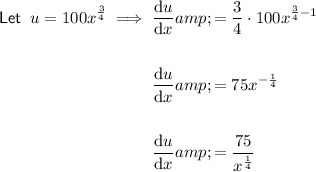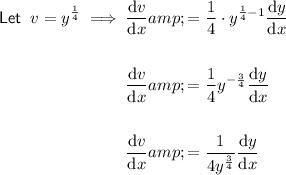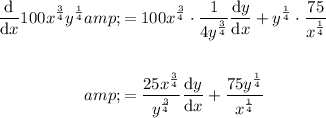Answer:




Explanation:
Question 1


To find y'(25), begin by differentiating √x + √y = 7 using implicit differentiation.
Place d/dx in front of each term of the equation:


Differentiate the terms in x only (and the constant term):

Use the chain rule to differentiate terms in y.
In practice, this means differentiate with respect to y, and place dy/dx at the end:


Rearrange to isolate dy/dx:



The expression y'(25) means the value of dy/dx when x = 25.
Given that y = 4 when x = 25, substitute these values into the equation for dy/dx to find y'(25):


Therefore, the value of y'(25) is -2/5.

Question 2

To find dy/dx, begin by placing d/dx in front of each term of the equation:

Differentiate the constant:

Differentiate the left side of the equation using the product rule.



Therefore:

Rearrange the differentiated equation to isolate dy/dx:




To find the value of dy/dx at point (81, 16), substitute x = 81 and y = 16 into dy/dx:

Therefore, the value of dy/dx at the point (81, 16) is -0.5926, rounded to 4 decimal places.

Question 3

To find the formula for the slope of the tangent line at point (x, y) on the ellipse, differentiate the equation of the ellipse using implicit differentiation.
Begin by placing d/dx in front of each term of the equation:

Differentiate the terms in x only (and the constant term):


Use the chain rule to differentiate terms in y.
In practice, this means differentiate with respect to y, and place dy/dx at the end:

Rearrange to isolate dy/dx:


To find the slope of the tangent line at point (1, 4.84), substitute x = 1 and y = 4.84 into dy/dx:

Therefore, the slope of the tangent line is -0.323, rounded to 3 decimal places.